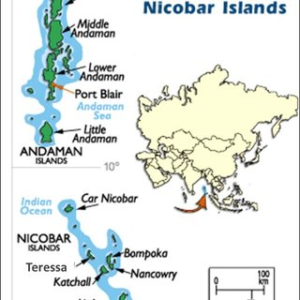In news- The United States National Aeronautics and Space Administration (NASA) recently highlighted the loss of mangrove cover on Katchal island, a part of India’s Nicobar archipelago.
Key findings-
- The NASA Earth Observatory depicted tidal wetland loss from 1999 through 2019 in orange colour.
- After the magnitude-9.2 Aceh-Andaman earthquake in December 2004, the islands experienced up to 3 meters (10 feet) of land subsidence.
- This submerged many mangrove ecosystems, resulting in a loss of more than 90 percent of mangrove extent in some areas.
- Some 27 per cent of the losses and gains were directly caused by human activity.
- Other causes of wetland change were sea level rise, shoreline erosion, storms, altered sediment flow and subsidence.
- The study also found that outside of Asia, tidal wetlands in Africa had the highest ratio of loss to gain, most severe in Nigeria, Mozambique and Guinea-Bissau.
- The mangrove cover on Katchal will not come back. But in other places, mangroves have reappeared since they propagate themselves through propagules.
- A propagule is a vegetative structure that can become detached from a plant and give rise to a new plant. Examples include a bud, sucker, or spore.
About Katchal island-
- Katchal Island was previously known as Tihanyu.
- It is approximately 1,600 km away from mainland (India) and 305 km south to capital Port Blair.
- The hills of Katchal are composed of calcareous sandstone and marble slates.
- It is home to both indigenous and non-indigenous people.
- Katchal is inhabited by Nicobari Tribes and Migrated Tamilians.
- It is the largest island of the central group of islands.
- Languages spoken in Katchal are Nicobarese, Hindi, Tamil, Telugu and Santali.
- After the tsunami almost all the tribal chiefs and their heirs were killed, leaving the tribes virtually headless.
- Katchal Island belongs to the township of Nancowry of Katchal tehsil.
- Due to the remote location and lack of exposure with the rest of the world, outsiders economically exploited the innocent islanders for a long time.
- To stop their economic exploitation, the Government of India declared the Nicobar Islands an Aboriginal Tribal Reserve Area (ATRA) on 2 April 1957.

- This made the Nicobar Islands inaccessible to outsiders and currently even Indian nationals need a special tribal pass to visit the islands.
- Only Government Servants (outsiders) posted to Katchal Islands are allowed to stay on the island.
















